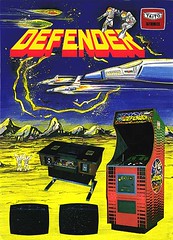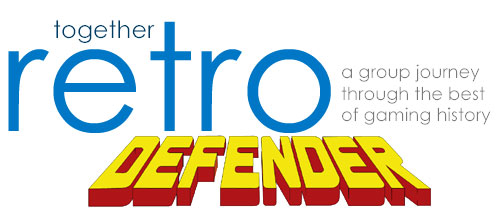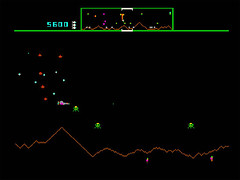Together Retro Game Club: Defender
Presented by: Fastbilly1, Marurun, & Racketboy
New To Together Retro? Check out the introduction to the club
 We have a special treat for you this opening week. We’re going to be looking at the arcade classic Defender and the home port for the Atari 2600. Read on to find out more about Defender and what our plan is for the next 2 weeks.
We have a special treat for you this opening week. We’re going to be looking at the arcade classic Defender and the home port for the Atari 2600. Read on to find out more about Defender and what our plan is for the next 2 weeks.
History
Williams Electronics threw the gaming world a curveball when they released Defender in 1980. The game featured an unheard of control array for a standard upright game and a difficulty that remains formidable to this day. Very few games can claim the title “Hardest Game Ever” and only one other can claim “Over a billion dollars in the Arcade” – take a guess at which one.
Defender is a simple (hah!) game about saving the world from an invading race of mutants. While it does build on what previous coin poppers laid out for it, Defender takes the game to the next level. To summarize the difficulty, during testing the highest score obtained was 50,000 points. The programmers almost did not add any stages past that because they felt no one would ever reach them. When the game was debuted at the AMOA (Arcade Manufacturers of America) trade show in 1979 it was blasted as too complicated and no one thought it would catch on. Both Defender and Pacman were predicted to fail in the arcades. Ironically those are the only two coin-op games to break the one billion dollars mark.
Recommended Ports
The best way to play Defender is obviously on the original hardware. However, since most of us don’t have the space or proper salary for one or more arcade cabinets, if that, we will have to settle for ports and emulation. (Learn how to emulate and configure Defender)
The home port we are going to focus on is the Atari 2600 one, as it was the most prevalent one on the market. While it may not technically be the best port, the Atari 2600 version of Defender is fairly faithful to the original game and an impressive show of how the Atari 2600 can indeed handle a complex and difficult game. Changes to the control scheme were one of Atari’s biggest concessions, along with changing the plain mountain background to a more colorful, if blocky, cityscape. Among the sacrifices necessary to make the game playable with the single button Atari controller is the elimination of hyperspace and having to fly off screen and hit the fire button to use a smart bomb. You’ll have to own the Atari cartridge or emulate this one as it hasn’t shown up on any of the Atari TV game collections such as the Flashback. Here’s a video for a look at the Atari 2600 port in action
The most available modern arcade port and the best legal alternative to the original arcade cabinet would be either the version found on the Midway Arcade Treasures discs or the Xbox Live Arcade version.
| Atari 2600 | PS2/PS3 | Gamecube/Wii | XBox | XBLA |
 |
 |
 |
 |
 |
Controlling the Game
Defender features a joystick and five buttons. The joystick is a classic 2-way stick mounted vertically, meaning the stick only goes up and down. To move left and right you have to use the reverse button (turns you around) and the thrust button (propels you). The reverse button is right by the stick, accessible with the thumb of the left hand. The hyperspace button is in the middle of the panel, forward a bit, below the 1 and 2 player buttons. Smart bomb, thrust, and fire are in a cluster placed properly for right-hand access. The location of the hyperspace button has made for Defender teams, featuring the player and the so called “Hyper Space” position. To help you out, take a look at the pictures linked below. The text is a little fuzzy due to low quality images so refer to the description above to confirm button locations.
It should be noted that in most home ports the controls were simplified so that a d-pad or joystick controls the ship in four directions instead of two – taking away the thrust button. Just hold left or right to lay out extra thrust. This makes the game easier to control but reduces the tactical possibilities available for the truly nimble. The hyperspace function was also removed in many home ports.
Gameplay
The controls make it sound easy, right? Well, mostly you’re just flying around, shooting enemies. In addition shooting down enemies and staying alive by avoiding contact with enemies and their bullets, however, you additionally have to try to keep all your humanoids from getting abducted by enemy landers. Destroy the lander and the humanoid falls. If he falls too far he dies. You can catch the falling humanoid and drop him off on the ground for extra points, not to mention the score bonus for having more surviving humanoids left at the end of the level. A successful abduction by a lander results in a mutant which, as you’ll read next, is more than enough reason to keep them from getting captured.
The enemies you’ll face are just despicable enough to show you why “old school” is the only school when it comes to crushing difficulty. Intentionally programmed to give you false hope is the best way to describe the AI in Defender. You have your standard stupid, enemy bombers. You have pods which, when shot, blow up to become a swarm of tiny, erratic swarmers. To top it all off, if you don’t wipe out the enemy wave quickly enough, a baiter will hunt you down with precise shots and deadly speed. And of course there are the landers, destined to grab a humanoid when you least expect it. Let the lander get away and you’ll end up facing a mutant, an erratic and aggressive foe.
The levels scroll by smoothly and wrap around, making it feel like you have an infinite space to fly in. You have a radar display at the top of the screen which shows you, with colored dots, where you are and what’s going on around you. It can be extremely helpful assuming you have time to look at it. You probably won’t. And don’t get too pissed off as cheap deaths are to be expected.
The goal of the game is simply to get the highest score possible, and like most classic arcade games it goes on forever. The score only runs up 999,999 and rolls over to 0 if you pass it. If you are feeling adventurous, or just think you are that good, you can go for the world record. Hosted on Twin Galaxies the current record for marathon gaming is 79,976,975, set by Chris Hoffman back in 1981 (standard game settings). If you end up beating that you will have accomplished something monumental and there might be a documentary out there with your name on it…King of Kong anyone?
Strategy and How To Play Effectively
The best guide I have found so far on how to play Defender is on the useful site, Strategy Wiki. Not only does it have clear and concise tips, but since it is a wiki, you can also contribute to it as well.
- Characters
- The Scanner
- Beginning Strategies
- Reverse Strategy
- Hyperspace Strategy
- Smart Bomb Strategy
Additional Resources for Defender Information
- Defender Wikipedia Entry
- GameSpot’s Greatest Games entry on Defender
- The Killer List of Video Games Defender page
- The Ultimate History of Video Games
- Arcade Fever: The Fan’s Guide To The Golden Age of Video Games
- Supercade: A Visual History of The Videogame Age 1979-1984
- Collecting Classic Video Games
Together Retro Goals & Discussion
Instead of posting in the comments section of the blog, we will be using the forum for all of our discussion in order to keep things more organized. Since older arcade games like Defender are rather straightforward, our main “goal” here will be to get a respectable high score.
Affiliate programs and affiliations include, but are not limited to, the eBay Partner Network or Amazon Associates.


